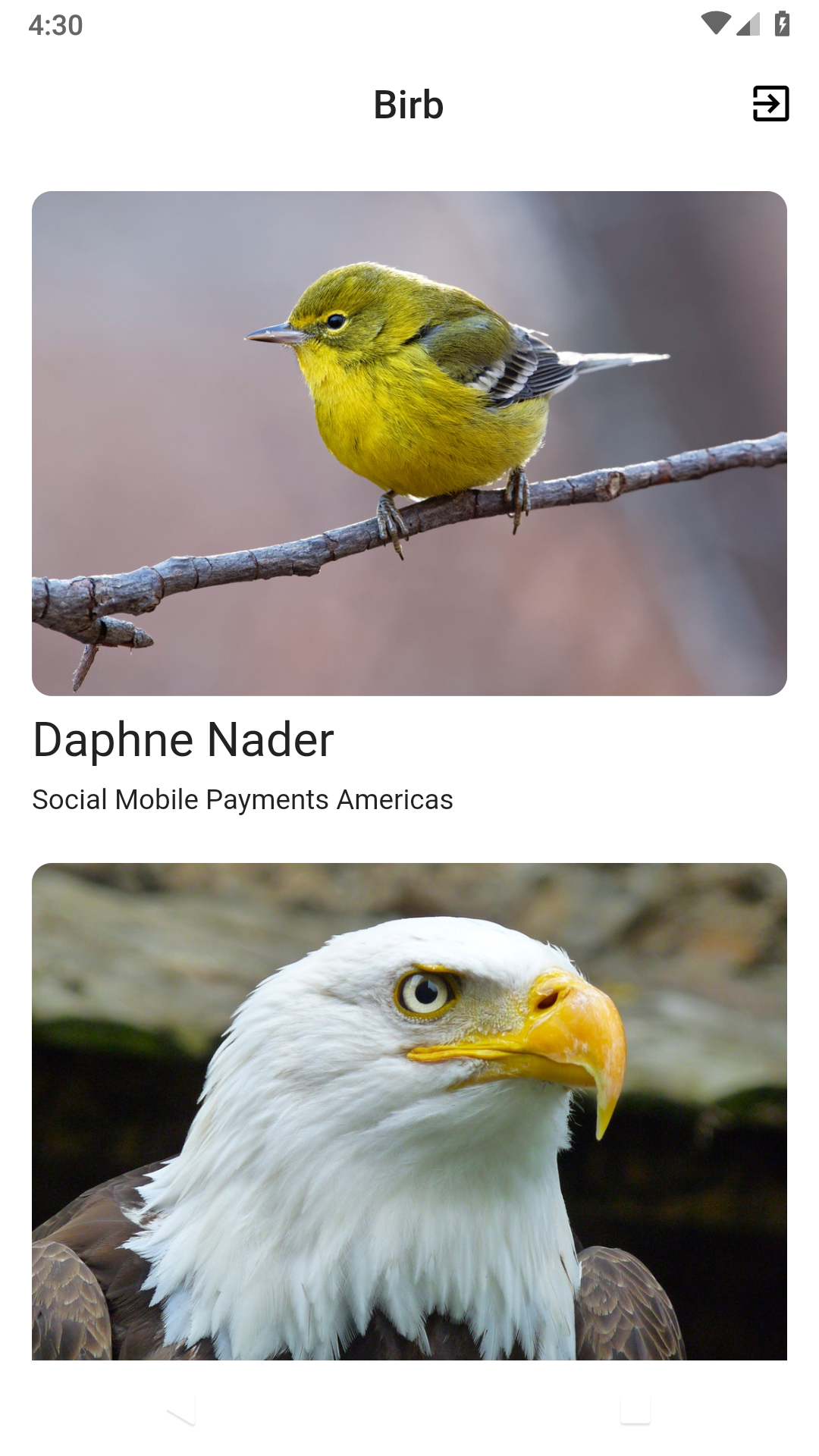A month of Flutter: user registration refactor with reactive scoped model

Yesterday I implemented saving new users to Firestore but I wasn't happy with the implementation. So today I refactored everything, well not everything but a lot. There are still areas for improvement but I like the general pattern being used now.
Now there is a top level ScopedModel that tracks the current authentication status. This sets up a listener on FirebaseAuth and Firestore and will get pushed changes when either have changed. Children widgets that need to change functionality based on authentication status will get rerendered as needed.
A couple of the less important changes that I'll get out of the way now.
Authwas renamed toAuthService- The Firestore rules were updated to allow a user to read their own user document
- Registration/sign in success
SnackBarwas replaced with an unstyled welcome view HomePagegotrouteNameadded
In MyApp's build, MaterialApp has been wrapped in ScopedModel<CurrentUserModel>. I put ScopedModel at the top because authentication changing will touch almost all of the app.
ScopedModel<CurrentUserModel>(
model: CurrentUserModel.instance(),
child: MaterialApp(
debugShowCheckedModeBanner: false,
title: 'Birb',
theme: buildThemeData(),
home: const HomePage(title: 'Birb'),
routes: <String, WidgetBuilder>{
RegisterPage.routeName: (BuildContext context) =>
const RegisterPage(),
},
),
)
ScopedModel takes a model, which in this case is CurrentUserModel (I'm not 100% in on that name yet) and acts similar to an InheritedWidget. Any children can find and interact with the CurrentuserModel instance or be conditionally rendered based on its state.
Coming from a background in web development, I thinkf of Models differently than ScopedModel does. Typically I think of models as single data objects like a blog post or tweet. In ScopedModel land, it's more like a store or state machine and can manage the state of several things.
I have set the CurrentStatusModel to have one of three statues:
enum Status {
Unauthenticated,
Unregistered,
Authenticated,
}
Unauthenticatedis the initial defaultUnregisteredthe user has authenticated through FirebaseAuthenticatedis when the user has authenticated, agreed to the Terms of Service, and aUserdocument has been saved to Firestore
Here is the new CurrentUserModel definition:
class CurrentUserModel extends Model {
CurrentUserModel({
@required this.firestore,
@required this.firebaseAuth,
@required this.userService,
});
CurrentUserModel.instance()
: firestore = Firestore.instance,
firebaseAuth = FirebaseAuth.instance,
userService = UserService.instance(),
authService = AuthService.instance() {
firebaseAuth.onAuthStateChanged.listen(_onAuthStateChanged);
}
Status _status = Status.Unauthenticated;
Firestore firestore;
FirebaseAuth firebaseAuth;
UserService userService;
User _user;
FirebaseUser _firebaseUser;
AuthService authService;
static CurrentUserModel of(BuildContext context) =>
ScopedModel.of<CurrentUserModel>(context);
User get user => _user;
Status get status => _status;
FirebaseUser get firebaseUser => _firebaseUser;
Future<void> signIn() {
return authService.signInWithGoogle();
}
Future<void> signOut() {
return firebaseAuth.signOut();
}
Future<void> register(Map<String, String> formData) async {
await userService.createUser(_firebaseUser.uid, formData);
}
Future<void> _onAuthStateChanged(FirebaseUser firebaseUser) async {
if (firebaseUser == null) {
_firebaseUser = null;
_user = null;
_status = Status.Unauthenticated;
} else {
if (firebaseUser.uid != _firebaseUser?.uid) {
_firebaseUser = firebaseUser;
}
_status = Status.Unregistered;
if (firebaseUser.uid != _user?.id) {
_user = await userService.getById(_firebaseUser.uid);
}
if (_user != null) {
_status = Status.Authenticated;
}
}
notifyListeners();
_listenToUserChanges();
}
void _onUserDocumentChange(DocumentSnapshot snapshot) {
if (snapshot.exists) {
_user = User.fromDocumentSnapshot(snapshot.documentID, snapshot.data);
_status = Status.Authenticated;
} else {
_user = null;
_status = Status.Unregistered;
}
notifyListeners();
}
void _listenToUserChanges() {
if (_firebaseUser == null) {
return;
}
// TODO(abraham): Does this need any cleanup if uid changes?
firestore
.collection('users')
.document(_firebaseUser.uid)
.snapshots()
.listen(_onUserDocumentChange);
}
}
I have created a named constructor so that I can call CurrentUserModel.instance() and it will use the default services. The number of services this relies on is large and I think can be cleaned up in the future.
The first neat bit is firebaseAuth.onAuthStateChanged.listen(_onAuthStateChanged). This adds a listener to FirebaseAuth and anytime the user signs in or signs out the callback will be called.
There is a static of method for the convenience of being able to call CurrentUserModel.of(context) for easy access to the state.
static CurrentUserModel of(BuildContext context) =>
ScopedModel.of<CurrentUserModel>(context);
The signIn, signOut, and register methods perform as they are named. They do consolidate a number of service dependencies into CurrentUserModel but I'm not sure this is the best place to have them.
_onAuthStateChanged is the work horse of this class. Anytime FirebaseAuth changes, this gets called and has to figure out what's going on. In essence if there is no user, it clears all the state, if the user is new or different it tries to get the User document. Lastly it will notify children that the state has changed and will start listening to changes to the User document.
_listenToUserChanges will listen to Firestore for changes to the authenticated user's document. One neat aspect is it can start listening before the document even exists and will get notified when it's created (from registering).
Lastly in CurrentUserModel is _onUserDocumentChange. If the document exists the user is authenticated and registered.
I also added a User model. It doesn't do much yet but handles taking a Firestore document and and turning it into a more manageable class instance.
To make implementation easier, I added a SignOutAction widget to the AppBar in HomePage. This simply renders an Icon and calls CurrentUserModel.of(context).signOut() on tap.

Another change in HomePage is to wrap the SignInFab widget in a ScopedModelDescendant<CurrentUserModel>. This will cause it to get rebuilt when CurrentUserModel notifies its children of state changes. The builder callback has to return a Widget so I just return an empty Container if the user is authenticated.
Widget _floatingActionButton() {
return ScopedModelDescendant<CurrentUserModel>(
builder: (
BuildContext context,
Widget child,
CurrentUserModel model,
) =>
model.user == null ? const SignInFab() : Container(),
);
}
RegisterPage similarly gets updated with a ScopedModelDescendant<CurrentUserModel> wrapper. This use is being a little smarter and will show the form if the user is authenticated but not registered and a welcome message once the user finishes registering. This message will need to be improved.
ScopedModelDescendant<CurrentUserModel>(
builder: (
BuildContext context,
Widget child,
CurrentUserModel model,
) {
if (model.status == Status.Unregistered) {
return const RegisterForm();
} else if (model.status == Status.Authenticated) {
return const Center(
child: Text('Welcome'),
);
} else {
return const CircularProgressIndicator();
}
},
)
I haven't fleshed out all the tests yet but a lot of the code now has dependencies on CurrentUserModel so I added a simple appMock to makes this easier.
ScopedModel<CurrentUserModel> appMock({
@required Widget child,
@required CurrentUserModel mock,
}) {
return ScopedModel<CurrentUserModel>(
model: mock,
child: MaterialApp(
home: Scaffold(
body: child,
),
routes: <String, WidgetBuilder>{
RegisterPage.routeName: (BuildContext context) => const RegisterPage(),
},
),
);
}